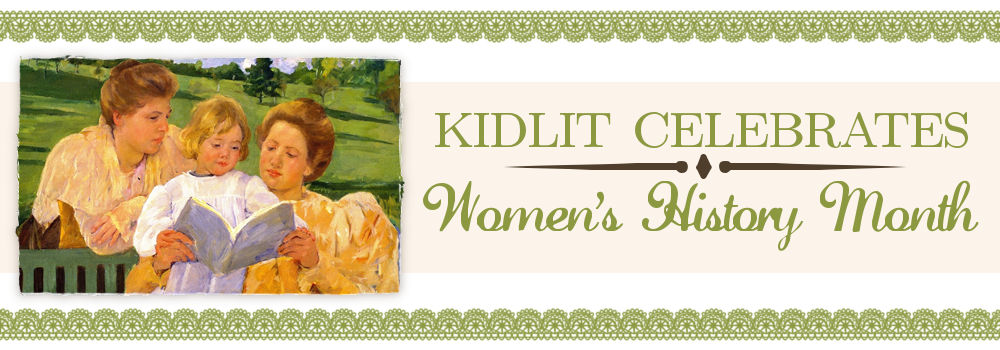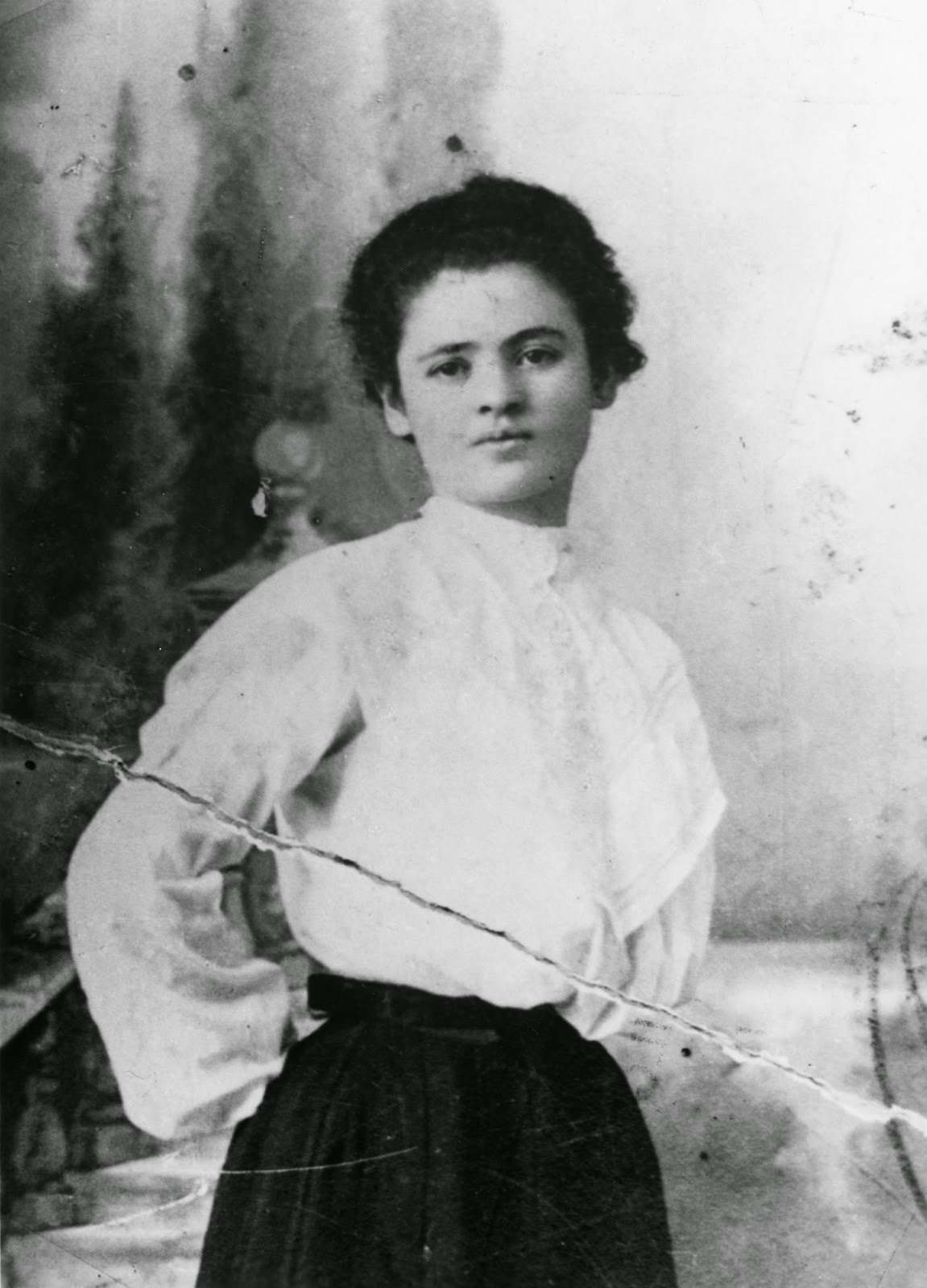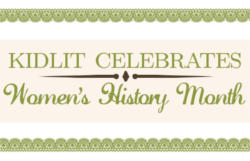Monday, February 29, 2016
Happy Women's History Month 2016
After five years of Kidlit Celebrates Women's History Month and many fascinating posts, we are taking a hiatus from the blog this year due to other commitments. Many thanks to all of those who have been following our posts and to the many authors and bloggers who have contributed in past years. We are excited with the many new books out this year on outstanding women and hope you will be exploring them this month. This year's theme of "Working to Form a More Perfect Union: Honoring Women in Public Service and Government" is particularly timely as the possibility of a female president--or at least a female presidential candidate for one of the major parties--becomes increasingly likely. What better time to educate young people about the important role of women in history.
Friday, April 3, 2015
Women's History--it's not just for March!
April 3 - Today's post contributed by Margo Tanenbaum and Lisa Taylor
Many thanks to all the participants and readers who have helped make Kidlit Celebrates Women's History Month's 5th year a success. This year we have enjoyed posts from and about contemporary women making history, such as ballerina Misty Copeland and chef Alice Waters, as well as historic figures such as Louisa May Alcott, Melba Liston and Anna May Wong. And let's not forget the women whose names we may never know (see letter X in Rad Women A-Z). Let's remember these women not only in March, when we celebrate Women's History Month, but throughout the year. Librarians, teachers, authors, parents, and students can advocate to include women in the curriculum all year long, and perhaps we'll see a day when women in history will no longer need their own special month.
Monday, March 30, 2015
Interview with Melanie Crowder, author of Audacity (Philomel, 2015)
March 30 - Today's post contributed by Margo Tanenbaum
Radical Jewish women rabble-rousers are getting their due in young people's books in the past few years. After being featured in the 2013 picture book Brave Girl: Clara and the Shirtwaist Makers' Strike of 1909, by Michelle Markel and illustrated by Melissa Sweet, labor leader Clara Lemlich is now the subject of author Melanie Crowder's recently published YA novel-in-verse, Audacity. Clara Lemlich (1886-1982), a Russian-born Jewish immigrant who came to New York at the age of 19 and almost immediately began working in the Lower East Side's garment sweatshops, is best known for sparking the Uprising of 20,000, a huge strike of shirtwaist workers in 1909 and the largest strike in U.S. history up to that time.
Crowder's terrific novel is a must read for all young people who hope to change the world. Although Audacity deals only with Lemlich's early years, Lemlich continued to advocate for the downtrodden throughout her life; in her last years in a nursing home she even organized the orderlies. She is the embodiment of "tikkun olam", a Jewish phrase meaning "repairing the world," which has become synonymous with humanity's obligation to pursue social justice.
|
Q) What inspired you to write a novel about Clara Lemlich?
A) Clara is one of those people who is only given a single line in history books. Her story is so extraordinary, though—I am in awe of her bravery and her strength and the unflagging fight inside her. When I began digging deeper into her history and her origins, I knew I had to share her story with young readers.
A) Clara is one of those people who is only given a single line in history books. Her story is so extraordinary, though—I am in awe of her bravery and her strength and the unflagging fight inside her. When I began digging deeper into her history and her origins, I knew I had to share her story with young readers.
Really, I wanted more than just a
single line for Clara, and I wanted readers to know more of her as well.
Q) If you could have met Clara
Lemlich in person, what would you have liked to ask her?
A) Wow—great question!
I would love to hear Clara talk about
the proudest moments in her life. I’m guessing that day at Cooper Union [when she gave the fiery speech that inspired the Uprising of 20,000] would be up there, but
I think I would also hear about her family. She lived a full life. She was an
activist her entire life. I would love to just sit and listen to her recall the
moments when life gave her moments of joy in return for all she gave to us.
Q) Do you see Clara Lemlich as a role
model for today's young women? and what social causes do you think she would be involved
in today?
A) Absolutely! There is so much about
her experience that resonates with young people today: the immigrant story, the
importance of education, her legacy as an activist, the evidence that an
individual really can make a difference. I think she is an inspiration and a
role model for us all—young
and old, male and female.
If I had to guess, I’d say Clara would still, to this day,
be fighting for workers’ rights.
I think she would be very interested in the fair trade movement, and in the
struggle in this country for pay equity between genders.
Q) Can you comment on how Clara
Lemlich might have seen the ongoing struggle for rights for garment workers
around the world? In many ways, nothing seems to have changed from the time of
the Triangle Fire, except that the worst sweatshops have moved overseas.
A) It wasn’t in Clara to be defeated, but I think she would have been
really discouraged by the current state of the garment industry. I know she
would have been devastated by the factory collapse in Bangladesh. Clara was an
excellent public speaker and I believe she would be out there today, lobbying
politicians and working to educate consumers about the origins of their
clothing and the social cost of cheap labor.
Q) Why did you choose to tell Clara's
story in free verse?
A) You know, I started telling her story
in prose and I didn’t get
very far. It just didn’t work.
It felt flat—not
quite enough to capture the intensity and tenacity with which she
approached life. When I began experimenting in free verse, I found what I was
looking for—a form
that amplified the emotion, the struggle, and the triumphs of her journey.
Q) Can you tell us what books you are
currently reading? Do you read a lot of YA fiction, or a variety of genres?
A) I do read a lot of YA and Middle
Grade fiction—there
are so many excellent books out there! Add to that the academic nonfiction I
read in order to research my stories and my TBR pile never seems to diminish! A
sampling from my nightstand at the moment:
Gabi, A Girl in Pieces by Isabel Quintero
Race, Gender and Punishment by Mary Bosworth and Jeanne Flavin
Roller Girl by Victoria Jamieson
Melanie, thanks so much for this interview and for participating in Kidlit Celebrates Women's History Month.
Melanie, thanks so much for this interview and for participating in Kidlit Celebrates Women's History Month.
Melanie Crowder received many honors for her debut novel, Parched, including Bank Street’s Best Books of the Year, a Junior Library Guild selection, a Silver Medal in the Parents’ Choice Awards, and a starred review from the Bulletin. Her second book, Audacity, has received three starred reviews and is an Editor’s Choice at BookBrowse and a Top Pick from BookPage. Her third novel, A Nearer Moon, releases September 8 from Atheneum Books / S&S. The author holds an MFA from Vermont College of Fine Arts. When she isn’t writing, Melanie can be found teaching, reading, daydreaming or exploring the beautiful state of Colorado where she lives with her family.
Sunday, March 29, 2015
Woman Who Faced Amazing Challenges & Succeeded
March 29 - Today's post contributed by Alyson Beecher
Woman Who Faced Amazing Challenges & Succeeded
by Alyson Beecher
My simple search produced some familiar names and some names that were new to me. Helen Keller was obviously on the list but so was Harriet Tubman, and Frida Kahlo. Each of these women have numerous biographies written about them in both picture book and long-form. The famous photographer, Dorothea Lange is well known for her photography but lesser known for the limp she grew up with as a result of polio when she was a child. Wilma Mankiller, Principal Chief of the Cherokee Nation, has a chapter in a picture book celebrating famous woman and her work with the Cherokee Nation, but did you know she also served in this position while having a rare form of muscular dystrophy? Really, just a chapter in a picture book?
However, I learned about some other woman who had made notable contributions to their communities and countries and yet, little were written about them. Jhamak Ghimire who has severe cerebral palsy and considered the “Helen Keller of Nepal” has nothing written about her in the United States, except for her own work of poetry. Judy Neumann, and Harilyn Rousso have had significant careers and lives advocating for individuals with disabilities and yet despite their life's work would not be easily recognized by most teachers and children.
After serving on the Schneider Family Book Award Jury (a children’s and young adult book award committee of the American Library Association) for the past few years, I have read a lot of books featuring individuals with special needs. However, in the category for young children, with the exception of books about Helen Keller, there were no books portraying the lives of any of these other amazing woman and the work that they have done while also living with additional challenges. Do we have a book gap? I would certainly say yes.
Though this is not a comprehensive list by any means, I would like to highlight the lives of just a few of the incredible woman who embody the spirit and essence that surrounds Women’s History Month and who are also powerful role models for our young readers who may be empowered to dream beyond their special needs because of these amazing women.
 |
| Moses: When Harriet Tubman Led Her People to Freedom by Carole Boston Weatherford; Illustrated by Kadir Nelson |
 |
| Frida by Jonah Winter; Illustrated by Ana Juan |
 |
| Viva Frida by Yuyi Morales |
One of the things that have always struck me is how Frida Kahlo was able to utilize her pain and life experiences to produce so many amazing pieces of art. As a child, she contracted polio and was left with a limp, then at 18 she was in a serious bus accident, which left her in chronic pain. Kahlo lived a colorful live with her marriage to artist Diego Rivera and her political activism.
 |
| Dorothea Lange by Mike Venezia |
 |
| Amelia to Zora: Twenty-six Women Who Changed the World by Cynthia Chin-Lee; Illustrated by Megan Halsey, Sean Addy |
 |
| Photo of Wilma Mankiller taken at the 2001 Cherokee National Holiday. Photo by Phil Konstantin |
 |
| Harilyn Rousso |
 |
| Judith Heumann, Photo from U.S. State Department |
 |
| "Jhamakawarded" by Madan Puraskar org . Licensed under CC BY-SA 3.0 via Wikimedia Commons http://commons.wikimedia.org/wiki/File:Jhamakawarded.jpg#/media/File:Jhamakawarded.jpg |
 |
| Helen’s Big World: The Life of Helen Keller by Doreen Rappaport; Illustrated by Matt Tavares |
What strikes me about each of these women is how hard they must have worked. Each one of these women shows us what is possible despite our personal limitations. When I think of the headaches that Harriet Tubman experienced or the chronic pain of Frida Kahlo, I am in awe. Pain is hard and yet, neither of these women allowed it to stop them from accomplishing what they were meant to do.
Mankiller, Heumann, and Rousso dedicated their lives to advocating for others. When I look at the accomplishments of these women, I almost feel like an underachiever. They have not allowed what might be seen by others as limitations to limit them.
Lange, Kahlo, and Ghimire have used their experiences to enhance their artistic expression. Ghimire is particularly inspiring in that her own country as well as her body would have left her without a voice and yet through her writing she has found that voice.
Next time, I find myself thinking I am unable to do something, I need to remind myself how much each of these women have contributed to their communities and even the world by what they were able to accomplish while facing incredible challenges.
 Alyson Beecher is an educator, book geek and literacy advocate with over 20 years of experience in education. Currently, she is the K-8 Literacy Specialist for the Pasadena Unified School District in Pasadena, CA. Alyson has served as the Chair of the ALA 2015 Schneider Family Book Award Jury and was an Elementary/Middle Grade Nonfiction second round judge for the CYBILS. She can be found on twitter @alybee930 or through her blog www.kidlitfrenzy.com
Alyson Beecher is an educator, book geek and literacy advocate with over 20 years of experience in education. Currently, she is the K-8 Literacy Specialist for the Pasadena Unified School District in Pasadena, CA. Alyson has served as the Chair of the ALA 2015 Schneider Family Book Award Jury and was an Elementary/Middle Grade Nonfiction second round judge for the CYBILS. She can be found on twitter @alybee930 or through her blog www.kidlitfrenzy.com
Posted by
shelf-employed
7 comments:

 Labels:
activists,
artists,
compendiums,
Dorothea Lange,
Frida Kahlo,
Harilyn Rousso,
Harriet Tubman,
Helen Keller,
Jhamak Ghimire,
Judy Heumann,
leaders,
photographers,
poets,
Wilma Mankiller
Labels:
activists,
artists,
compendiums,
Dorothea Lange,
Frida Kahlo,
Harilyn Rousso,
Harriet Tubman,
Helen Keller,
Jhamak Ghimire,
Judy Heumann,
leaders,
photographers,
poets,
Wilma Mankiller
Subscribe to:
Posts (Atom)
















